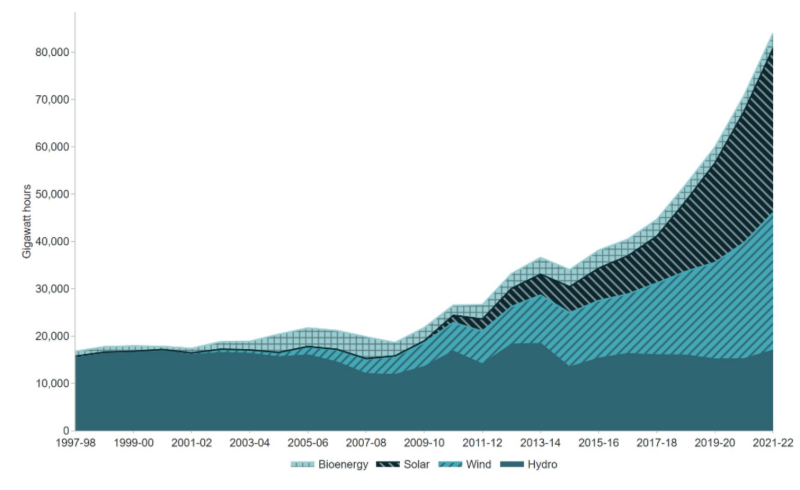Japan’s largest oil and gas E&P company, Inpex, is investing $1.25 billion (200 billion yen) through 2030 in Australian renewable energy, aiming to eventually create a hub for the export of green hydrogen while also aiding the Ichthys natural gas and LNG project to decarbonize.
Business media Nikkei Asia first reported the investment figure in mid-July as Inpex stepped up its foray into the renewables world which had begun in September 2023 with the purchase of 50% of shares in Enel Green Power Australia (EGPA), a subsidiary of Italian utility company Enel.
It was not until 14 June of this year that the joint-venture (JV) deal bore first fruit with the announcement of EGPA’s final investment decision (FID) to launch construction later in the year on the Quorn Park Hybrid photovoltaic and battery energy storage system (BESS) in New South Wales—the Japanese energy company’s first FID on a renewables project in Australia.
Battery Storage Stabilizes Delivery of Solar Power to the Grid
The Quorn Park Hybrid Project will provide a power supply by combining a 98 MWdc (80 MWac) of photovoltaic (solar) power generation and 20 MW/40 MWh battery energy storage system connected to a grid, EGPA reported in a news release.
Considered one of Australia’s most advanced hybrid projects, the $190-million Quorn Park project expected to come online in early 2026 is designed to maximize revenue and stabilize the grid by efficiently charging and dispatching solar-generated electricity.
EGPA currently operates three solar plants totaling 310 MW of installed gross capacity and one 76 MW wind project in Australia. The JV is constructing a 93-MW solar project as it plans a continentwide rollout of solar, onshore wind, and storage battery projects to boost its renewable capacity to between 2,000 and 4,000 MW by 2030, according to EGPA.
After 2030, some renewable power not consumed domestically is expected to flow to the Ichthys natural gas project off Australia’s northern coast and LNG plant to support its decarbonization by reducing the amount of electricity supplied by gas-powered generators currently in use.

Inpex holds a 67.82% operator interest in Ichthys which is regarded as one of the few projects globally that incorporates all links in the LNG production chain starting with deep offshore gas production, including two floating production units, a gas pipeline and ending with a liquefaction plant.
In 2023, Ichthys accounted for half of Inpex's roughly 7 million tons of greenhouse-gas emissions which the Japanese operator hopes to reduce with a tool kit that includes carbon capture and storage (CCS) along with consumption of electricity generated from renewables.
Its partners in Ichthys include TotalEnergies (26%), CPC Taiwan (2.625%), Osaka Gas (1.2%), Kansai Electric Power (1.2%), JERA (0.735%), and Toho Gas (0.42%).
Technology-Sharing Benefits Japan’s Own Energy Transition
While EGPA is focused currently on Australia, Inpex is destined to leverage know-how developed there to support potential projects in Japan including offshore wind and geothermal power.
Inpex, which currently has no renewables projects in its home country, announced in a 22 July news release the start of geothermal exploration drilling this year in the Okuhida Onsengo district of Takayama City in Gifu Prefecture.
Kenji Kawano, senior executive vice president at Inpex, told Nikkei Asia, "It's difficult to earn big profits through power generation alone, so we'll (also) enter into [power] supply and demand adjustment and retail sales to generate profits" as part of the company’s transition strategy.
Hence, “storage batteries are starting to spread in Japan,” Kawano said.
Inpex is exploring the use of renewable energy to produce green hydrogen which could be combined with CO2 to create e-methane. Nikkei Asia reported that Inpex’s client Tokyo Gas is investing in e-methane production with Inpex intending to supply green hydrogen as a feedstock.
In September 2023, Worley was awarded the front-end engineering and development contract for the Central Queensland Hydrogen Project (CQ-H2) led by Stanwell Corp. (Australia) with Japanese trading house Marubeni Corp., gas distributor Iwatani, Kansai Electric Power, and Keppel Infrastructure Holdings (Singapore).
The project in southern Australia aims to produce 260,000 mtpa of green hydrogen for export from around 2031 to Japan. It would also supply hydrogen to an ammonia production facility, according to Marubeni.

Similarly, the world’s second-largest metals and mining company, Rio Tinto, and Japan’s Sumitomo Corp. announced plans in July 2023 to build a hydrogen pilot plant for the world’s first trial of refining lower-carbon alumina in Gladstone, Queensland, Australia.


